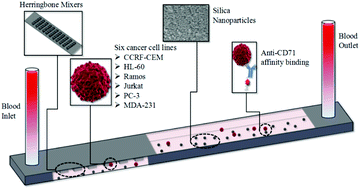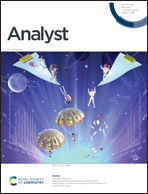Nanoparticle modification of microfluidic cell separation for cancer cell detection and isolation†
Abstract
Cancer is a major health problem in the United States with extremely high mortality. The detection and isolation of cancer cells are becoming increasingly important for cancer diagnosis. We describe a microfluidic device modified with silica nanoparticles to enhance the isolation of cancer cells using affinity separation. The isolation of seven different cancer cell lines spiked into liquid biopsies was demonstrated and compared with unmodified separation devices. Cancer cells were isolated using CD71 which has already been demonstrated to be a widespread “net” for capturing cancer cells of any phenotype as the affinity target. The capture efficiency of our nanoparticle (NP)-modified HB chip showed significant differences compared with the normal HB chip, exhibiting an average increase of 16%. The cell enrichment increased by a factor of 2 over unmodified chips. Patient-derived ALL cells, COG-LL-332, were spiked into blood with concentrations ranging from 1% to 20% of total leukocytes, and isolated with the purity of 41%–65%. The results of this study demonstrated that the increase of cell–chip interactions after nanoparticle modification improved capture efficiency and capture purity, and can be applied to a wide range of cell separations.



 Please wait while we load your content...
Please wait while we load your content...